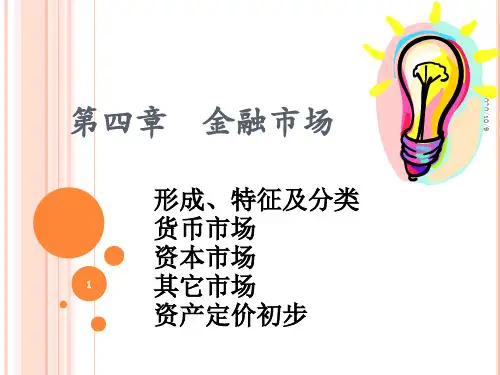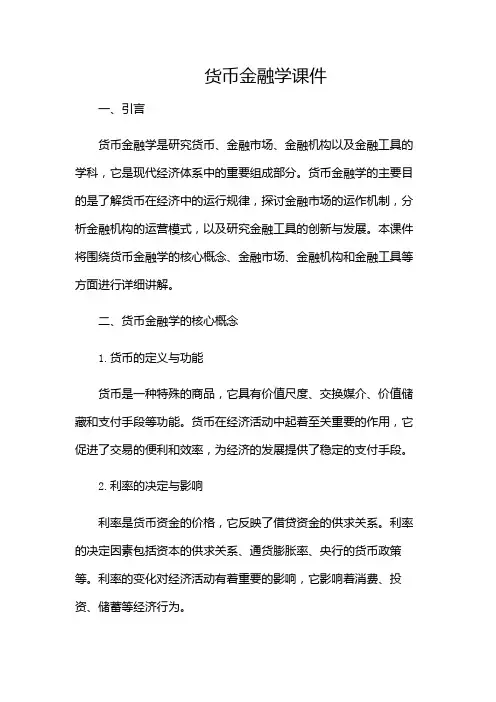最新[经济学]四川大学货币金融学第五章金融市场幻灯片课件
- 格式:ppt
- 大小:3.00 MB
- 文档页数:89





货币金融学课件一、引言货币金融学是研究货币、金融市场、金融机构以及金融工具的学科,它是现代经济体系中的重要组成部分。
货币金融学的主要目的是了解货币在经济中的运行规律,探讨金融市场的运作机制,分析金融机构的运营模式,以及研究金融工具的创新与发展。
本课件将围绕货币金融学的核心概念、金融市场、金融机构和金融工具等方面进行详细讲解。
二、货币金融学的核心概念1.货币的定义与功能货币是一种特殊的商品,它具有价值尺度、交换媒介、价值储藏和支付手段等功能。
货币在经济活动中起着至关重要的作用,它促进了交易的便利和效率,为经济的发展提供了稳定的支付手段。
2.利率的决定与影响利率是货币资金的价格,它反映了借贷资金的供求关系。
利率的决定因素包括资本的供求关系、通货膨胀率、央行的货币政策等。
利率的变化对经济活动有着重要的影响,它影响着消费、投资、储蓄等经济行为。
三、金融市场1.金融市场的定义与功能金融市场是指供求双方进行金融资产交易的场所,它包括货币市场、债券市场、股票市场等。
金融市场的功能主要包括资金融通、风险分散和价格发现等。
2.金融市场的参与者金融市场的参与者包括金融机构、企业和个人。
金融机构包括银行、保险公司、证券公司等,它们在金融市场中扮演着重要的角色,为市场提供融资、投资和风险管理等服务。
3.金融市场的运作机制金融市场的运作机制主要包括交易的规则和流程、市场的监管和法律框架等。
交易的规则和流程规定了市场的交易方式、交易时间和交易价格的确定等。
市场的监管和法律框架保证了市场的公平、公正和透明。
四、金融机构1.金融机构的定义与分类金融机构是指专门从事金融业务的机构,包括银行、保险公司、证券公司等。
金融机构的主要功能是资金的融通和风险管理。
2.商业银行的角色与功能商业银行是金融机构中最重要的一类,它的主要功能是吸收存款、发放贷款和提供支付结算服务。
商业银行在经济发展中起着重要的推动作用,它为企业和个人提供了融资的渠道,促进了经济的增长和繁荣。




FinanceChapter2 Financial MarketsInterest Rates and Calculation of Interest RatesThe Behavior of Interest RatesThe Risk and Term Structure of Interest RatesThe Stock Market, theTheory of Rational Expectations, and the Efficient Market HypothesisLecture 5The Behavior of Interest Rates•Determinants of Asset Demand•Supply and Demand in the Bond Market •Supply And Demand in the Money Market: The Liquidity Preference FrameworkLearning ObjectivesIdentify the factors that affect the demand for assets.Draw the demand and supply curves for the bond market and the money market, identify the equilibrium interest rate.List and describe the factors that affect the equilibrium interest rate in the bond market and the money market.Identify and illustrate the effects on the interest rate of changes in money growth over time.Interest Rate Determination Theory•Asset Demand Theory•Bond Supply and Demand Analysis •Money Supply and Demand Analysis ——(Liquidity Preference Framework)Part 1Determinants of Asset Demand1.1 Determinants of Asset DemandAsset is a piece of property that is a store of value.资产就是具有价值储藏功能的财产Money, bonds, stocks, art, land, houses, farm equipment, and manufacturing machinery are all assets.1.1 Determinants of Asset DemandDeterminants of Asset Demand:•Wealth: total resources owned by the individual, including all assets;•Expected return relative to other assets; (Expected return: the return expected over the next period)•Risk relative to other assets; (Risk: the degree of uncertainty associated with the return)•Liquidity relative to other assets; (Liquidity: the ease and speed with which an asset can be turned into cash)1.2 Theory of Portfolio ChoicePart 2Supply and Demand in the Bond Market2 Supply and Demand in the Bond Market2.1 Demand CurveConsider the demand for one-year discount bonds, which make no coupon payments but pay the owner the $1,000 face value in a year.If the holding period = years to maturity = 1 year, rate of return = interest rateii=RR=FF−PP PPwhere i= interest rate = yield to maturityRR= rate of returnF = face value of the discount bondP = initial purchase price of the discount bond2.1 Demand CurveIf the bond sells for $950, the interest rate and rate of return areii=RR=$1000−$950$950=0.053=5.3%At a price of $900, the interest rate and rate of return areii=RR=$1000−$900$900=0.111=11.1%Each bond price has a corresponding interest rate and expected rate of return2.1 Demand CurveAs predicted by portfolio theory, when the rate of return is higher, with all other economic variables (such as income, expected returns on other assets, risk, and liquidity) held constant, the quantity demanded of these bonds will be higher.根据资产需求的决定因素,当回报率上升时,其他要素不变,资产需求量也随之上升。

